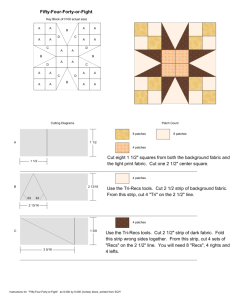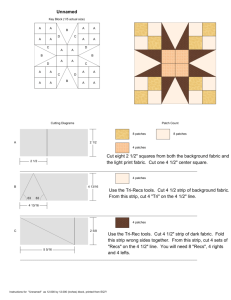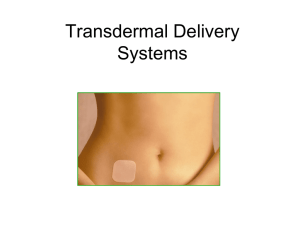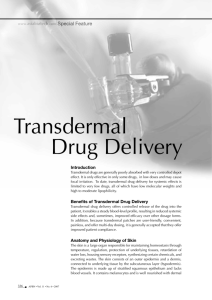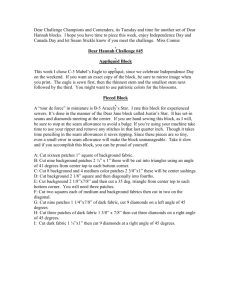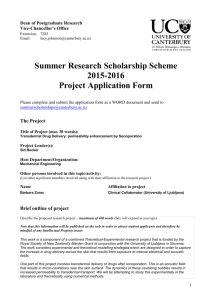Document 13308014
advertisement
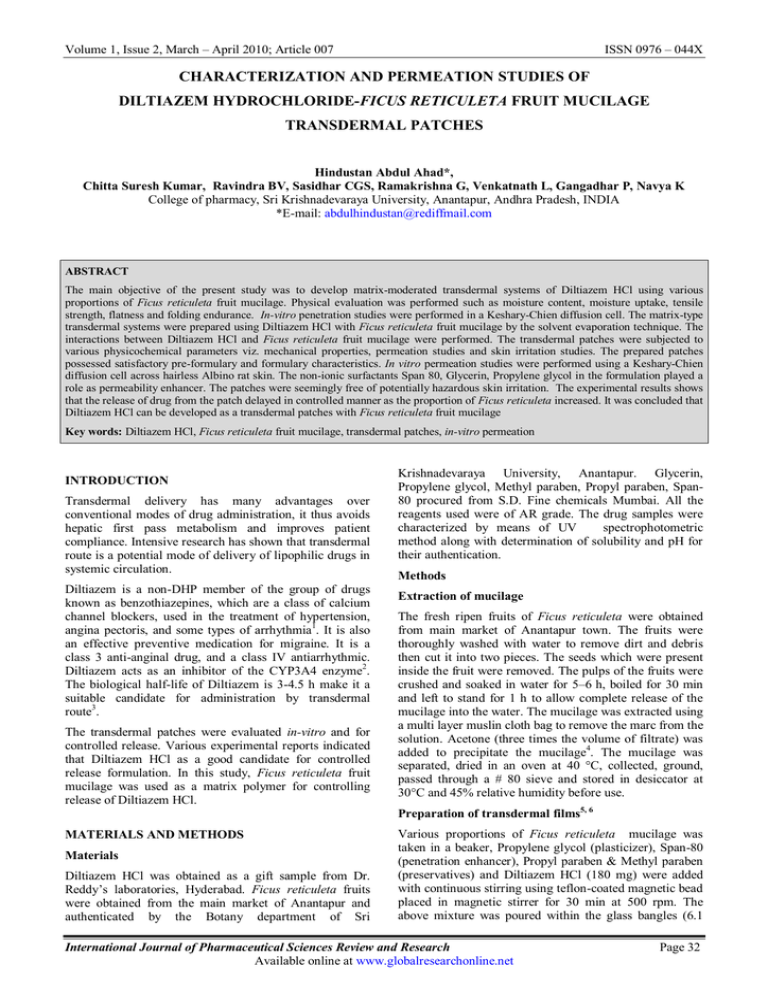
Volume 1, Issue 2, March – April 2010; Article 007 ISSN 0976 – 044X CHARACTERIZATION AND PERMEATION STUDIES OF DILTIAZEM HYDROCHLORIDE-FICUS RETICULETA FRUIT MUCILAGE TRANSDERMAL PATCHES Hindustan Abdul Ahad*, Chitta Suresh Kumar, Ravindra BV, Sasidhar CGS, Ramakrishna G, Venkatnath L, Gangadhar P, Navya K College of pharmacy, Sri Krishnadevaraya University, Anantapur, Andhra Pradesh, INDIA *E-mail: abdulhindustan@rediffmail.com ABSTRACT The main objective of the present study was to develop matrix-moderated transdermal systems of Diltiazem HCl using various proportions of Ficus reticuleta fruit mucilage. Physical evaluation was performed such as moisture content, moisture uptake, tensile strength, flatness and folding endurance. In-vitro penetration studies were performed in a Keshary-Chien diffusion cell. The matrix-type transdermal systems were prepared using Diltiazem HCl with Ficus reticuleta fruit mucilage by the solvent evaporation technique. The interactions between Diltiazem HCl and Ficus reticuleta fruit mucilage were performed. The transdermal patches were subjected to various physicochemical parameters viz. mechanical properties, permeation studies and skin irritation studies. The prepared patches possessed satisfactory pre-formulary and formulary characteristics. In vitro permeation studies were performed using a Keshary-Chien diffusion cell across hairless Albino rat skin. The non-ionic surfactants Span 80, Glycerin, Propylene glycol in the formulation played a role as permeability enhancer. The patches were seemingly free of potentially hazardous skin irritation. The experimental results shows that the release of drug from the patch delayed in controlled manner as the proportion of Ficus reticuleta increased. It was concluded that Diltiazem HCl can be developed as a transdermal patches with Ficus reticuleta fruit mucilage Key words: Diltiazem HCl, Ficus reticuleta fruit mucilage, transdermal patches, in-vitro permeation INTRODUCTION Transdermal delivery has many advantages over conventional modes of drug administration, it thus avoids hepatic first pass metabolism and improves patient compliance. Intensive research has shown that transdermal route is a potential mode of delivery of lipophilic drugs in systemic circulation. Diltiazem is a non-DHP member of the group of drugs known as benzothiazepines, which are a class of calcium channel blockers, used in the treatment of hypertension, angina pectoris, and some types of arrhythmia1. It is also an effective preventive medication for migraine. It is a class 3 anti-anginal drug, and a class IV antiarrhythmic. Diltiazem acts as an inhibitor of the CYP3A4 enzyme2. The biological half-life of Diltiazem is 3-4.5 h make it a suitable candidate for administration by transdermal route3. The transdermal patches were evaluated in-vitro and for controlled release. Various experimental reports indicated that Diltiazem HCl as a good candidate for controlled release formulation. In this study, Ficus reticuleta fruit mucilage was used as a matrix polymer for controlling release of Diltiazem HCl. Krishnadevaraya University, Anantapur. Glycerin, Propylene glycol, Methyl paraben, Propyl paraben, Span80 procured from S.D. Fine chemicals Mumbai. All the reagents used were of AR grade. The drug samples were characterized by means of UV spectrophotometric method along with determination of solubility and pH for their authentication. Methods Extraction of mucilage The fresh ripen fruits of Ficus reticuleta were obtained from main market of Anantapur town. The fruits were thoroughly washed with water to remove dirt and debris then cut it into two pieces. The seeds which were present inside the fruit were removed. The pulps of the fruits were crushed and soaked in water for 5–6 h, boiled for 30 min and left to stand for 1 h to allow complete release of the mucilage into the water. The mucilage was extracted using a multi layer muslin cloth bag to remove the marc from the solution. Acetone (three times the volume of filtrate) was added to precipitate the mucilage4. The mucilage was separated, dried in an oven at 40 °C, collected, ground, passed through a # 80 sieve and stored in desiccator at 30°C and 45% relative humidity before use. Preparation of transdermal films5, 6 MATERIALS AND METHODS Materials Diltiazem HCl was obtained as a gift sample from Dr. Reddy’s laboratories, Hyderabad. Ficus reticuleta fruits were obtained from the main market of Anantapur and authenticated by the Botany department of Sri Various proportions of Ficus reticuleta mucilage was taken in a beaker, Propylene glycol (plasticizer), Span-80 (penetration enhancer), Propyl paraben & Methyl paraben (preservatives) and Diltiazem HCl (180 mg) were added with continuous stirring using teflon-coated magnetic bead placed in magnetic stirrer for 30 min at 500 rpm. The above mixture was poured within the glass bangles (6.1 International Journal of Pharmaceutical Sciences Review and Research Available online at www.globalresearchonline.net Page 32 Volume 1, Issue 2, March – April 2010; Article 007 ISSN 0976 – 044X cm diameter) placed on mercury surface in a Petri dish. The rate of evaporation was controlled by inverting a funnel over the Petri dish. After 24 h the dried films were taken out and stored in desiccator. The quantities in the formulae were showed in Table 1. Table 1: Different formulae of Diltiazem HCl with Ficus reticuleta mucilage INGREDIENTS DFR-1 DFR-2 DFR-3 DFR-4 DFR-5 180 180 180 180 180 5 10 15 20 25 Glycerin(mL) 0.3 0.3 0.3 0.3 0.3 Propylene Glycol(mL) 0.18 0.18 0.18 0.18 0.18 Span-80 (mL) 0.06 0.06 0.06 0.06 0.06 Methyl paraben(g) 0.025 0.025 0.025 0.025 0.025 Propyl paraben(g) 0.015 0.015 0.015 0.015 0.015 Water up to (mL) 20 20 20 20 20 Diltiazem HCl(mg) Ficus reticuleta fruit mucilage (%) constant weight. The moisture content was the difference between the constant weight taken and the initial weight. Evaluation of Transdermal Films Thickness: The thickness of the patch was determined using Digital caliper (BAKER-EC 10, Hyderabad, India). The mean thickness was measured at five different points of the film. Determination of tensile strength: Tensile strength was determined by using computerized Precisa bottom-loading balance, with necessary modifications. A 1 X 1cm patch was taken and subjected to studies. Flatness and elongation brake: Longitudinal strips were cut out from the prepared transdermal patches. The flatness was determined at various points by using vernier calipers7. The percentage elongation brake was determined by noting the length just before the break point and substituted in the eq.1. Elongation (%) = L1 – L2 X 100/ L2 (1) Where L1 = final length of each strip L2 = initial length of each strip. Folding endurance: Folding endurance of patches was determined by repeatedly folding a small strip of film (2 X 2 cm) at the same place till it broke. The number of times the film could be folded at the same place without breaking was the folding endurance value8. Moisture content: The strips were then weighed individually and kept in a desiccator containing activated silica at 30°C for 12 h. The films were reweighed individually until a constant weight was obtained9. Percentage of moisture content was then calculated based on the change in the weight with respect to the initial weight of the film. The prepared patches were cut into 20 × 50 mm strips. The film was weighed and kept in a desiccator containing calcium chloride at 30°C and dried for at least 12 h. The film was weighed until it showed a Moisture uptake: The physicochemical studies like moisture content and moisture uptake provide the information regarding the stability of the formulation. The water absorption capacities of various films were determined at 75% and 93% relative humidity (RH). Films were cut into 25 × 60 mm strips. A strip was weighed and kept in a desiccator at 40°C for 24 h, removed and exposed to RH conditions of 75% (containing saturated solution of sodium chloride) and 93% (containing saturated solution of ammonium hydrogen phosphate) in different desiccators at room temperature. Then the films were measured periodically to constant weights. The water absorption capacity of the films (in weight %) was calculated in terms of percentage increase in the weight of film over the initial weight of the specimen. Drug content determination of film Four pieces of 1 cm 2 each (1 X 1 cm) were cut from different parts of the prepared transdermal patch. Each was taken in separate stoppered conical flasks containing 100 mL of suitable dissolution medium (0.1-N HCL: CH3OH mixture) and stirred vigorously for 6 h using magnetic stirrer. The above solutions were filtered and suitable dilutions were made. Absorbance was observed using UVVisible spectrophotometer (Systronics 117) at their respective wavelengths, against a blank solution which was prepared by the same protocol but not containing drug. In-Vitro skin permeation studies with polymeric matrices10-14: The transdermal patches were subjected to in-vitro evaluation across rat dorsal skin. After removal of epidermal hair, skin was cleaned and any adhering subcutaneous tissue and blood vessels were removed. The skin was mounted overnight (12 h) on receptor phase to remove any water-soluble (UV absorbing) material. The in-vitro skin permeation of Diltiazem HCl from various transdermal patches was studied using locally fabricated International Journal of Pharmaceutical Sciences Review and Research Available online at www.globalresearchonline.net Page 33 Volume 1, Issue 2, March – April 2010; Article 007 Keshary-Chien type of diffusion cell. The diffusion cell consists of two parts. The upper part is the donor compartment and contains the active ingredient and the carrier adhesive/patch; the bottom part contains the receptor solution, the water jacket for temperature control and the sampling port. ISSN 0976 – 044X Figure 3: Higuchi’s plots of Diltiazem HCl with Ficus reticuleta fruit mucilage The effective permeation area of the diffusion cell and receptor cell volume was 1.0 cm2 and 17.5 mL, respectively. The temperature was maintained at 37±2°C. The receptor compartment contained 17.5 mL of phosphate buffer saline (PBS) IP (pH 7.4) stirred by magnetic stirrer. The permeability studies were carried out across both rat and cadaver skin. Samples (1.0 mL) were withdrawn and replaced with the same volume of fresh receptor solution, through the sampling port of the diffusion cell at predetermined time intervals till 48 h. Absorbance of the withdrawn samples were measured at 238 nm. The experiments were done in triplicates, simultaneously blanks were also run and the average values reported. The in-vivo permeation data was treated with kinetic models15 and the resulted plots were represented in fig.1 to fig.5. Figure 4: Peppa’s plot of Diltiazem HCl with Ficus reticuleta fruit mucilage Figure 1: Zero order plot of Diltiazem HCl-Ficus reticuleta patches Figure 5: Hixson Crowell’s plot of Diltiazem HCl with Ficus reticuleta fruit mucilage Figure 2: First order plot of Diltiazem HCl with Ficus reticuleta fruit mucilage Evaluation of skin irritation potential of polymeric matrices The primary skin irritation studies were carried out using modified Draize test16. The hair of rabbits were removed by shaving from the dorsal area on both sides 24 h before test, one side of the back of each rabbit i.e. untreated skin International Journal of Pharmaceutical Sciences Review and Research Available online at www.globalresearchonline.net Page 34 Volume 1, Issue 2, March – April 2010; Article 007 area serves as the control for the test. Medicated patch was secured on experimental side using adhesive tape and the non-medicated patch was adhered on the control side of six rabbits17. These patches were covered with occlusive covering to approximate the condition of use. The medicated patches were changed after 48 hours and the fresh patches were secured at the same site. However the patches on the control side were not changed. The patches were secured on the back for seven days. After removal of patch after a week each of the areas were examined for any sign of erythema or edema. Table 4: Results of skin irritation test. Formulation Visual observation Erythema Edema Normal 0.00±0.00 0.00±0.00 Adhesive tape(USP) 1.31±0.21 1.60±0.25 DFR-5 (Diltazem HCl-patch) 1.52±0.35 1.24±0.17 Blank 1.51±0.14 1.18±0.42 Formalin (0.8% v/v) 3.75±0.18 3.39±0.36 Visual observation values are expressed as Mean ±SEM, n=6; * Significant compared to formalin (p<0.05); DFR-5=Diltiazem Ficus reticuleta fruit mucilage patch; Blank= Patch without drug Drug- Polymer Interaction studies: Interaction studies were conducted on the medicated TDDS formulations by comparing them with the pure drug and placebo formulations on the basis of assay, UV, IR and DSC analyses. Assay: The TDDS was dissolved in isopropyl alcohol and the drug content was determined by UV spectrophotometry. UV Analysis: The medicated and blank formulations were filtered through Whatman filter paper no. 42 and scanned spectrophotometrically in the range of 200–400 nm. IR analysis: The IR absorption spectra of the pure, medicated and blank formulations were taken in the range of 400–4000 cm–1 using the potassium bromide disc method (Hitachi-270-30 IR spectrophotometer, Japan). Differential Scanning calorimetry (DSC) (Perkin Elmer, USA) at scanning rate of 100C/ min between 50 to 3000C Stability studies: Stability studies were conducted according to the International Conference on Harmonization (ICH) guidelines by storing the TDDS samples at 40± 0.5 °C and 75 ± 5% RH for 3 months. The samples were withdrawn at 0, 30, 60 and 90 days and analyzed for drug content by HPLC (Waters, USA). The chromatographic conditions were as follows: column Lichrospher RP-18.5 µm (125×4 mm); mobile phase: methanol/0.01 mol L–1 disodium hydrogen phosphate (60:40); flow rate: 1.5 mL min–1; injection volume: 20 mL; detector: UV, 290 nm; Retention time: 5.5 min. ISSN 0976 – 044X RESULTS AND DISCUSSION Thickness: The thickness of formulated matrix transdermal patches were ranged from 630±35.6 to 690±25.6 Tensile strength: This indicates the strength of film and the risk of film cracking. But, no sign of cracking in prepared transdermal films was observed, which might be attributed to the addition of the plasticizer, Propylene glycol. The results of tensile strength were shown in Table 2. Tensile strength of formulated patches was ranges from 0.285 ± 0.25 to 0.326 ± 0.10 kg/cm2 Elongation: The elongation of formulated matrix transdermal patches were ranged from 15.330.89 to 26.230.84 Folding endurance: The folding endurance measures the ability of patch to withstand rupture. The folding endurance was measured manually and results indicated that the patches would not break and would maintain their integrity with general skin folding when used. The results of folding endurance were shown in Table 2. It was found to be high in patches containing higher amount of the Ficus reticuleta fruit mucilage and it was ranged from 98± 1.8 to 124±0.9. Moisture content: The results of the moisture content studies for different formulations are shown in Table 3. The moisture content varied to a small extent in all the trials. The moisture content of the prepared transdermal film was low, which could help the formulations remain stable and from being a completely dried and reduce brittleness during storage. The moisture content was ranged from 2.645±0.35 to 2.854±0.56% Flatness and elongation brake: Folding endurance of patches was determined by repeatedly folding the patch (2X2 cm) at the same place till it breaks. The number of time the film could be folded till it breaks is the endurance value. The value was ranged from 15.33±0.89 to 26.23±0.84. Moisture uptake: The results of moisture uptake studies for different formulations are shown in Table 3. The moisture uptake of the transdermal formulations was also low, which could protect the formulations from microbial contamination and also reduce bulkiness of films. At RH 75% the moisture content ranged from 2.210± 0.96 to 4.125± 0.52 and at RH 93% it ranged from3.906 ± 0.59 to 6.145 ± 0.01. Drug content determination of film: The drug content in formulated films were ranged from 97.4± 0.02 to 100.7± 0.45% Evaluation of skin irritation potential of polymeric matrices Studies: The patches did not show any visible erythema or edema with the formulation or the base used. Accelerated stability study In the present work stability study was carried out for selected formulation (DFR-5) at 40 ± 0.5 °C and 75 ± 5 % RH for 3 months18 using programmable environmental test International Journal of Pharmaceutical Sciences Review and Research Available online at www.globalresearchonline.net Page 35 Volume 1, Issue 2, March – April 2010; Article 007 ISSN 0976 – 044X chamber (Remi, India). The samples were evaluated for physicochemical parameters like thickness, flatness, folding endurance, tensile strength, moisture content and moisture uptake, drug content as well as drug release. The stability study indicates that the formulation is quite stable at accelerated conditions. Table 2: Result of mechanical properties of Diltiazem HCl transdermal patches Parameter Thickness (µm) Tensile strength (N/mm2) Elongation (%) Folding endurance DFR-1 630±35.6 0.294 ± 0.14 15.330.89 98± 1.8 DFR-2 650±62.5 0.285 ± 0.25 18.220.23 124±0.9 DFR-3 685±55.8 0.311 ± 0.05 22.660.36 115±1.2 DFR-4 690±25.6 0.325 ± 0.12 24.950.39 99±1.5 DFR-5 635±29.6 0.326 ± 0.10 26.230.84 119±1.4 Number of trials (n) = 3 Table 3: Result of mean weights, moisture content, moisture uptake and dug content of formulated transdermal patches Formulation Weights (g) Moisture uptake (%) Moisture content (%) RH 75% RH 93% Drug Content (%) DFR-1 1.561±0.51 2.848±0.12 3.206± 0.37 6.145 ± 0.01 97.4± 0.02 DFR-2 1.584±0.12 2.851±0.23 4.125± 0.52 5.249 ± 0.12 98.3± 0.19 DFR-3 1.564±0.14 2.645±0.35 3.130± 0.73 3.936 ± 0.49 99.7± 0.23 DFR-4 1.566±0.34 2.758±0.35 2.210± 0.96 5.219 ± 0.20 100.2± 0.22 DFR-5 1.597±0.01 2.854±0.56 3.206± 0.37 3.906 ± 0.59 100.7± 0.45 Number of trials (n) = 3 In vitro skin permeation studies with polymeric matrices: REFERENCES: The mechanical properties viz. thickness, tensile strength, elongation and folding endurance of formulated transdermal patches were within the limits and were represented in table 2. The mean weights, moisture content, moisture uptake (at RH 75% and RH 93%) and drug content of formulated transdermal patches were within the limits. The results of skin irritation studies showed negligible erythema with prepared films when compared with control. The absence of edema indicates that the polymeric patches are compatible with the skin and hence can be used for transdermal application. 1. Ramoska EA, Spiller HA, Winter M, Borys D. A oneyear evaluation of calcium channel blocker overdoses: toxicity and treatment. Annals of Emergency Medicine. 1993 Feb; 22(2): 196-200. 2. Grossman E, Messerli FH. Calcium antagonists. Progress in Cardiovascular Disease. 2004 Jul-Aug; 47(1): 34-57. 3. Claas SA, Glasser SP. Long-acting diltiazem HCl for the chronotherapeutic treatment of hypertension and chronic stable angina pectoris. Expert Opinion on Pharmacotherapy. 2005 May; 6(5): 765-76. CONCLUSION: 4. This investigation revealed that Ficus reticuleta fruit mucilage appears to be suitable for use as a matrix former in the manufacturing of transdermal patches because of its satisfactory physical and mechanical properties. The Invitro permeation data revealed that dried Ficus reticuleta fruit mucilage can be used as a matrix former in transdermal delivery systems. S.K. Baveja, K.V. Rao, and J. Arora, "Examination of Natural Gums and Mucilages as Sustaining Agents in Tablet Dosage Forms," Indian J. Pharm. Sci. 50 (2),1988, 89–92 5. Cleary GW, "Transdermal Delivery Systems: A Medical Rationale," in Topical Drug Bioavailability, Bioequivalence, and Penetration, Shah VP, and Maibach HI (eds), New York, Plenum, 1993, 17–68. ACKNOWLEDGMENTS: 6. Mukherjee B, Mahapatra S, Gupta R, Patra B, Tiwari A, Arora P. A comparison between povidoneethylcellulose and povidone-eudragit transdermal dexamethasone matrix patches based on in vitro skin permeation. Eur J Pharm Biopharm 2005; 59: 475483. The authors are thankful to Dr. Reddy’s laboratories, Hyderabad, India for providing a gift sample of Diltiazem HCl. International Journal of Pharmaceutical Sciences Review and Research Available online at www.globalresearchonline.net Page 36 Volume 1, Issue 2, March – April 2010; Article 007 ISSN 0976 – 044X 7. Arora P, Mukherjee B. Design, development, physicochemical, and in vitro and in vivo evaluation of transdermal patches containing Diclofenac diethylammonium salt. J Pharm Sci 2002; 91: 20762089. 8. Tanwar YS, Chauhan CS, Sharma A.Development and evaluation of carvedilol transdermal patches. Acta Pharm 2007; 57: pp151-159. 9. Gupta R, Mukherjee B. Development and in vitro evaluation of diltiazem hydrochloride transdermal patches based on povidone-ethyl cellulose matrices. Drug Dev Ind Pharm 2003; 29: 1-7. 10. Ubaidulla U, Reddy VS, Ruckmani S. Transdermal therapeutic system of carvedilol: effect of hydrophilic and hydrophobic hatrix on in vitro and in vivo characteristics. AAPS PharmSciTech 2007; 8: E1-E8. 11. The United States Pharmacopoeia, 2000. United States Pharmacopeial Convention Inc: 1941. 12. Jain.N.K, Controlled and novel drug delivery, first edition, CBS publishers and distributors, New Delhi.1997. 13. Cleary GW, "Transdermal Delivery Systems: A Medical Rationale," in Topical Drug Bioavailability, Bioequivalence, and Penetration, Shah VP, and Maibach HI (eds), New York, Plenum,1993, 17–68. 14. McCarley KD, Bunge AL. Review of pharmacokinetic models of dermal absorption. J Pharmaceut Sci. 2001; 90: 1699-1719. 15. Hadgraft J. Modulation of the barrier functions of the skin. Skin Pharmacol Appl Skin Physiol. 2001; 14(suppl 1): 72-81. 16. Draize JH, Woodward GS, Calvery HO. Method for the study of irritation and toxicity of substances applied topically to the skin and mucus membrane. J Pharmacol Exp Ther 1994; 82: 377-90. 17. Kligman AM, Christopher E. Preparation of isolated sheet of human stratum corneum. Arch Dermatol 1963; 88:702. 18. Remunan C, Bretal M, Nunez A, Bila Jato JL. Accelerated stability of sustained release tablet prepared with Gelucire. Int J Pharm. 1992; 80: 151159. *********** International Journal of Pharmaceutical Sciences Review and Research Available online at www.globalresearchonline.net Page 37

